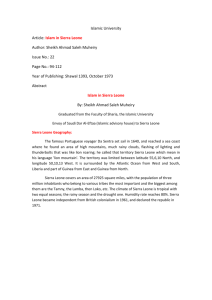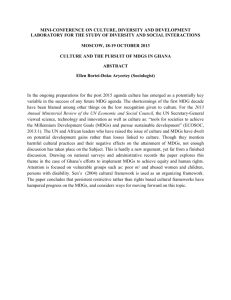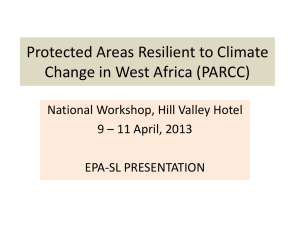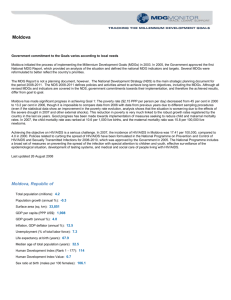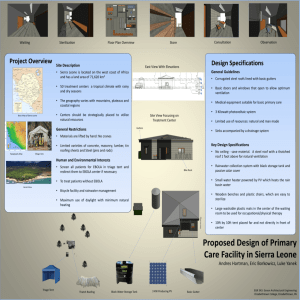Africa: diversity and development
advertisement
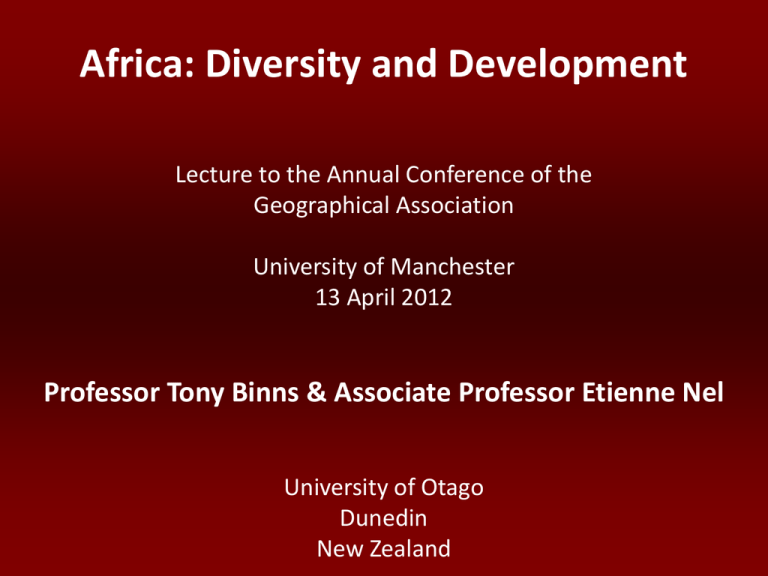
Africa: Diversity and Development Lecture to the Annual Conference of the Geographical Association University of Manchester 13 April 2012 Professor Tony Binns & Associate Professor Etienne Nel University of Otago Dunedin New Zealand Introduction This presentation - closely linked with conference theme of “Geographies of Difference” Africa – an ideal case example of “geographies of difference” – this theme will form a key basis of this presentation. Recent developments in Africa – link with key themes in the Geography curriculum We will draw on our recently published book Africa’s place in the School Curriculum - can be linked to the following ‘A’-level and GCSE curriculum themes: Contemporary geographical issues World cities / changing urban and rural environments Development and globalization Development and inequality / development gap Development dilemmas / world development Contemporary conflicts Population and resources / population change Managing resources 1. 2. Africa - can be used as an exemplar of: * Key themes in the curriculum e.g. development /resources/conflict, and * Recent rapid changes & current issues of global contestation e.g. food shortages/climate change/the MDGs Focus of this presentation: 1. Changing perceptions of the continent 2. Africa’s diversity 3. Selected key themes: a) Africa and the MDGs b) Recent trends – Growth and challenges c) Food security d) Post-conflict 4. Conclusion Africa – the world’s poorest continent, but recent positive signs: Better economic performance in the last/current recession than most continents: 35% of Africans live in countries with +4% growth for last 10 years Africa’s middle class has increased to 313 million (c. 33% of population) Estimated 100,000 African millionaires Fewer coups : 24 in the 1960s, 5 in the 2000s More democracy Major advances in cell-phone / internet banking The 56 Countries of Africa 49 mainland states & 7 island states* Algeria Angola Benin Botswana Burkina Faso Burundi Cameroon •Cape Verde Central African Republic Chad •Comoros Congo (Brazzaville Congo, DRC, Zaire) Cote d`Ivoire Djibouti Egypt Equatorial Guinea Eritrea Ethiopia Gabon Gambia Ghana Guinea Guinea-Bissau Kenya Lesotho Liberia Libya •Madagascar Malawi Mali Mauritania •Mauritius Morocco Mozambique Namibia Niger Nigeria [ •Reunion] Rwanda •Sao Tome & Principe Senegal •Seychelles Sierra Leone South Africa Sudan South Sudan Tanzania Togo Tunisia Uganda Western Sahara Zambia Zimbabwe Africa’s Diversity Africa is the Second largest continent after Asia – 30,065,000 sq km., 20.2% of Earth’s land surface Population in 2011 – + 1 billion Most populated country – Nigeria: c.150 million (2009) Africa’s Diversity Life expectancy: 72 years Algeria 35 yrs Lesotho Malnutrition (% under-5s): 45% Burundi 4% Tunisia Under 5 mortality: 282 Sierra Leone 13 Seychelles HIV/AIDS (% 15-49): GDP pc: $12,387 Botswana $667Malawi Under $1 /day: 3% Egypt 70% Nigeria HDI: 52/187Seychelles 187/187 DRCongo Sources: UNDP, 2007, 2009; World Bank, 2009; FAO 2009. 0.1% Algeria 33.4% Swaziland Theme A: Africa and the Millennium Development Goals (MDGs) Adopted by the UN General Assembly in 2000 8 globally agreed development targets to achieve by 2015. While many countries in Asia and Latin America are on track to meet them, many African countries sadly will not. What are the MDGs ? Goal 1: Eradicate extreme poverty and hunger Target 1: Reduce by half the proportion of people living on less than a dollar a day Target 2: Reduce by half the proportion of people who suffer from hunger Goal 2: Achieve universal primary education Target 3: Ensure that all boys and girls complete a full course of primary schooling Goal 3: Promote gender equality and empower women Target 4: Eliminate gender disparity in primary and secondary education preferably by 2005, and at all levels by 2015 What are the MDGs (contd). • Goal 4: Reduce child mortality Target 5: Reduce by two thirds the under-5 mortality rate Goal 5: Improve maternal health Target 6: Reduce by three quarters maternal mortality Goal 6: Combat HIV/AIDS, malaria and other diseases Target 7: Halt and begin to reverse the spread of HIV/AIDS Target 8: Halt and begin to reverse the incidence of malaria and other major diseases Goal 7: Ensure environmental sustainability Goal 8: Develop a global partnership for development Attaining the MDGs Africa still has the highest proportion of people of any region in the world living on less than $1.25 per day. This figure fell from 58 to 51% between 1990-2005, but Developing World average fell from 45% to 27% (UN MDG Report, 2011) % of children who are underweight in Africa fell 27%-22% (1990-2009). Slow improvement in health and educational scores in Africa. Adult literacy (over 15 yrs) only 40.9% in Sierra Leone Theme B: Recent Trends: Growth and Challenges While there are some positive signs in Africa, many deepseated challenges remain which are hindering the attainment of the MDGs and broader development goals Some of the most obvious challenges include: - rapid urbanization and under-resourced cities - refugee crises and lingering conflict / corruption - health crises – especially HIV/AIDS and malaria - persistent poverty - significant disparities – spatially and socially Africa’s 10 largest cities in 2008 1. Cairo 2. Lagos 3. Kinshasa 4. Khartoum 5. Luanda 6. Alexandria 7. Abidjan 8. Johannesburg 9. Algiers 10. Cape Town 12.1 m 9.8 m 8.2 m 4.8 m 4.2 m 4.2 m 3.9 m 3.2 m 3.4m 3.2m Recent Trends Development challenges and backlogs will remain for some time But scope to explore recent positive economic trends and emerging themes of interest, including; - Chinese investment - Climate change - Global food and oil shortages and land acquisition in Africa Theme C: Food Security “Food security exists when all people, at all times, have physical and economic access to sufficient, safe and nutritious food to meet their dietary needs and food preferences for an active and healthy life” (FAO, 1996) Food security is important to achieve at least 4 of the MDG’s Goal 1: Eradicate extreme poverty and hunger Goal 4: Reduce child mortality Goal 5: Improve maternal health Goal 6: Combat HIV/AIDS, malaria and other diseases Food security in Africa Report by FAO in 2006 suggested that; Food insecurity and undernourishment are widespread in Africa, And undernourishment actually increased in Africa by around 20% between 1990 and 2002. This is in stark contrast to the rest of the world, where the number of undernourished people has fallen steadily. Urban agriculture: a key strategy to ensure food security The context *Rapid growth of Africa’s towns and cities *Rising prices of basic foodstuffs *Increasing importance of urban and peri-urban agriculture (UPA) - vegetables, fruit, some grain crops (e.g. maize). The value of UPA - supplements household food intake - provides extra income from crop sales - provides employment - empowers women and youths - enhances the sustainability of cities, increased self-sufficiency - a useful adaptation to climate change. Theme D: Conflict and Post-Conflict Reconstruction Between 2000 and 2010 – armed conflict in 24 African countries “The costs of war in Africa have cancelled out the potential impact of 15 years of development aid” (UN Deputy Secretary-General, 2010) Conflict leads to; - collapse of economic systems - increase in military expenditure, and other sectors neglected (e.g. health, education) - destruction of state infrastructure e.g. roads, power, health, education, legal system - destruction of community and household infrastructure - deaths from conflict, but also from disease and starvation with poor health care - widespread suffering, trauma and dislocation Sierra Leone Much in the news in recent years - synonymous with conflict and diamonds Civil war: 1991-2001 – caused by poor governance, disaffected youths, instability in Liberia Massive displacement of people and destruction of infrastructure - more than 500,000 people displaced Major economic activities disrupted, including farming, mining and forestry People flooded into the capital city, Freetown, for safety, increasing the demand for food. Sierra Leone today… Now one of the poorest countries in the world UNDP, Human Development Report, 2011 (data for 2009) HDI rank, 180 out of 187 Life expectancy at birth: 47.8 years (UK: 80 years) Adult literacy: 40.9% Infant mortality rate (per 1,000 live births): 123 (UK: 5/1000) Under-5 mortality: 192 per 1000 live births (UK: 6/1000). Post-conflict reconstruction and development in Sierra Leone Key priorities Disarmament and stability Democratic and non-corrupt governance at all levels Re-patriation for refugees Re-incorporation of ex-combatants into communities Community-based education overcome trauma and plan for development Reconstructing infrastructure - roads, schools, hospitals, telecommunications Job creation, particularly for youths Restoring systems - health, education, economy, taxation, trade, legal, tv and radio. Conclusion Perceptions of Africa are often negative Africa has been marginalised and has a lot of catching up to do But many positive things are happening in Africa Africa is the continent to watch in the years ahead South Africa joined the BRIC’s group of rapidly developing countries in 2011 To find out more, please read our book!!


